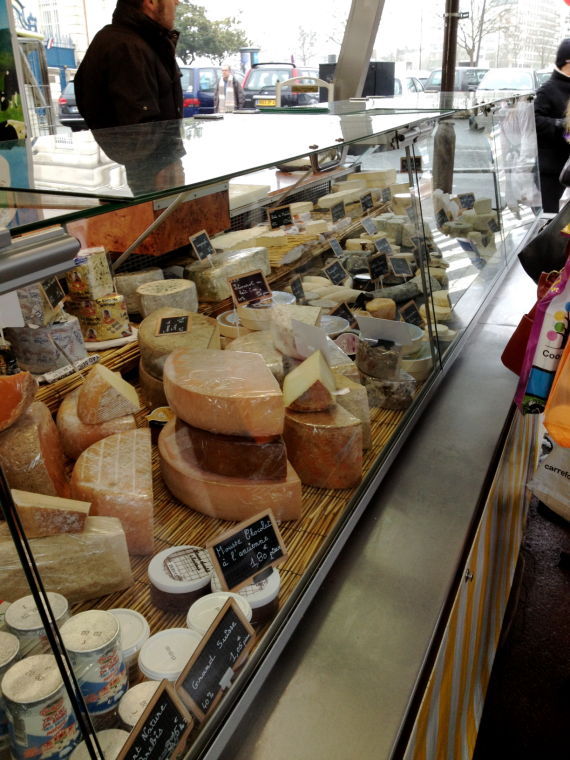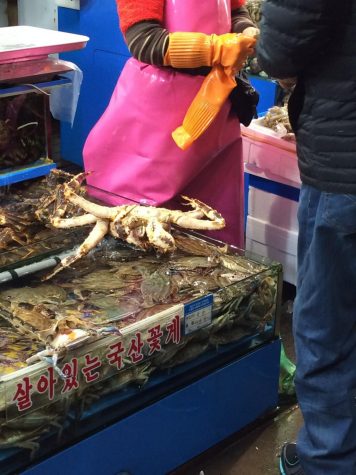ANGERS: Bringing a baguette to class
Here in Angers, I am taking a class called “Experiencing French Life and Culture.” Our homework for today was to bring with us half a baguette for a cheese and charcuterie tasting — not a bad way to start the week if you ask me.
Having been here a month, I have of course seen lots of cheese and lots of the preserved meats they call charcuterie. They both have impossible-to-miss sections in the grocery store and at the Saturday market I have made a habit of going to.
They have such huge selections, in fact, that I have been utterly overwhelmed and have mostly avoided even trying to buy something. While my French language classes have naturally covered basic grocery shopping vocabulary, they have utterly failed me when it comes to coming up against the vast culture that is French cheese and charcuterie.
I had been looking forward to this class for some time.
Before we tried anything, our fearless French guide, Marie, handed out packets of information including a long long list of charcuterie specialities (the realm of salting, smoking, and brining meat is endless) as well as a breakdown of the type of cheese with which we were about to be acquainted.
Though charcuterie can be served in numerous settings (as both a main course and as hors d’oeuvres), apparently it always goes before cheese if there is any.
Trusting Marie and my love of meat, I tried everything and thoroughly enjoyed almost everything. The following is how I now stand on charcuterie:
Andouille is smokey salty deliciousness. I have never thought myself a tripe person (cow stomach guts), but I am also not going to question it.
When I describe a kind of charcuterie as “fatty,” I am merely being honest and mean that rich and delicious taste that you just have to have sometimes. For example, with rillette, when meat (normally pork) is cooked in fat, shredded and pounded into a paste to be packed into a container, or terrine, and preserved with more fat.
Once you get over whatever it is that may be stopping you from eating minced meat paste, pâté is the perfect meaty spread for one’s baguette.
I imagine a million Frenchmen cringing at the association, but saucisson à l’ail is like pepperoni but times a million and made by garlic gods.
I still maintain that I will eat pretty much everything except for olives, but I will only ever have one bite of boudin noir. The pork blood sausage is a little bit too much for me.
Having been completely blown away by the sheer amount of jambon, or ham, that is found in every single home and restaurant in France, I thought that more of our charcuterie would be ham-based. However Marie varied the selection and only a few pig-products made it to our dégustation.
Because it was my lucky day, after all that charcuterie, there was cheese. Our cheese platter included seven cheeses from different parts of France. There was Trois Cornes, a goat cheese from the Pays-de-la-Loire; a Tomme Fermière and Abondance de prairie from the Alpes; Crottin de Chavignol, a goat cheese from the heart of France; Brin d’Amour aux herbes from Corsica; Chablis from Burgundy; and Roquefort made from Ewe in the Midi-Pyrénées.
I would name one as my favorite, but I have a feeling that I would keep changing it as I continued to recall everything I had.
I will say that I quite enjoyed all the savory and salty herbs found on the the Brin d’Amour aux herbes. I additionally will be thinking about for at least some time to come exactly how it was to have the Chablis (named that way because the cheese is washed once a week with Chablis) melt in my mouth.
Whether I want to or not, I will also be remembering the Roquefort and how quickly it shattered all my preconceived notions of a “strong” cheese.
As I made my way through my cheese plate, I learned a few other things about the world of cheese. For example, there are around 500 variations of cheese produced in France. And the average French person consumes 24.5 kg of cheese a year – almost double that of an American at 12.3 kg.
I also technically have a whole new stock of phrases of words to use at my next cheese tasting: “pungent,” “rich meatiness,” “fruity undertones,” “acidic,” “soft,” “velvety,” “balanced,” “grassy,” “supple,” “smooth,” “pronounced,” “salty,” “crumbly,” “nutty vegetation,” “robust,” “sour,” “complex,” “buttery,” and “aggressive.”
Both Marie and our pre-dégustation packet had more information on the cheese we ate (the history of each, exactly how and with what products it is made, what size it should be etc.) that I want to share with you, but there is simply too much. This blog post would never end and it needs to end because I must go buy some more charcuterie and cheese.
In future posts, however, I hope to return to the conversation of French cheese and charcuterie especially as it reflects regional significance.








